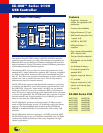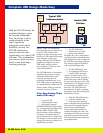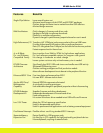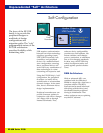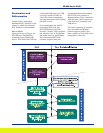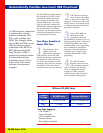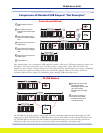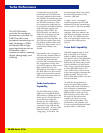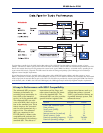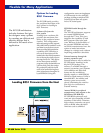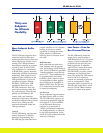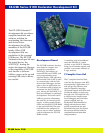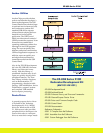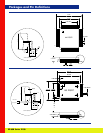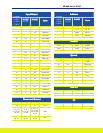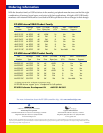
EZ-USB Series 2100
Turbo Performance
To make full use of the USB
bandwidth, the EZ-USB family
has large endpoint buffers and a
fast method for transferring data
into and out of the buffers. With
the EZ-USB architecture, bulk
and isochronous endpoints can
be configured as double-buffered
with maximum packet sizes.
With the 2-Kbyte FIFO, the
EZ-USB family can transfer a
1024-byte isochronous packet
within a single USB frame.
Similarly for bulk endpoints, the
EZ-USB can transfer data using
the 64-byte double buffer capa-
bilities at a data transfer rate of
greater than 2 Mbytes per
second.
Fast transfer rates can occur in
and out of the internal FIFOs to
external peripherals since the
EZ-USB core automatically
monitors 8051 transfers between
the accumulator and the end-
point FIFO registers. When one of
these transfers occurs, the
EZ-USB core also reads or writes
the FIFO data over the external
data bus and provides external
FIFO read and write strobes for
the external interface.
Turbo Isochronous
Capability
The EZ-USB family provides
1024 bytes of double-buffered
FIFO memory (2048 bytes in all)
which may be divided between
16 isochronous endpoints.
During any one millisecond
frame time, one of the FIFOs is
connected to the USB and the
other to the 8051. At every SOF
(Start Of Frame), the buffers
“ping-pong” so the 8051 can
access the last frame’s data while
the other FIFO empties or fills
with new USB data.
A single “movx” instruction
transfers data between EZ-USB
endpoint FIFOs and external logic
in two cycles or 330 nano seconds.
Based on these connections a
complete 1024-byte transfer can
take 388 microseconds, less than
40% of the 1 ms USB frame time.
This is an equivalent transfer rate
of greater than 2 Mbytes per
second.
Turbo Bulk Capability
USB bulk endpoint data is avail-
able to the 8051 as 16 64-byte
buffers in RAM. A special bulk
data pointer allows this RAM data
to also be accessed as a FIFO. The
8051 loads this sixteen-bit pointer
with the address of a bulk buffer.
Then, using a special data register,
accesses the buffer data as if it
were a FIFO. Every read or write
to the data register increments the
address pointer. This gives the
8051 a third data pointer: one that
auto-increments.
As with the fast isochronous
mode, the special data register
uses the turbo mode that allows a
byte of data to be transferred
using a single “movx” instruction.
Bulk transfers in and out of the
8051 therefore can be done with
the speed of the isochronous
transfers, one byte every two
cycles (330 nanoseconds). This
performance can generate well
over the maximum allowable bulk
packets within a USB frame.
The EZ-USB family
provides the maximum
performance specified for
USB. This allows the
peripheral manufacturer to
take advantage of USB’s
full bandwidth in high-
speed applications such as
full-motion video,
continuous audio, scanning,
digital photography, and
printing.



